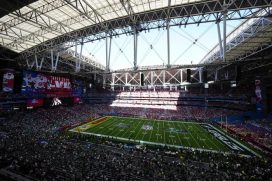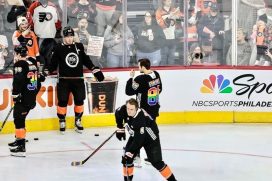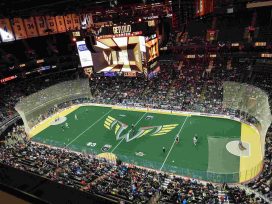Patrick Causey, on Twitter @PhillySportsJD
I chose not to do a scouting report on Jahlil Okafor before the draft because it seemed unlikely the Philadelphia 76ers would even have a chance at drafting him.
Boy, was I wrong.
Okafor's fall to the number three pick seemed impossible just six months ago. He was the consensus number one pick in this class since his freshman year in high school. And he won at every level along the process. But despite the success, Okafor became subject to the magnifying glass that is the NBA Draft process, and his draft stock tumbled, slightly, because of perceived holes in his game.
Some of the criticisms of Okafor's game were legitimate: Okafor's defense is subpar — at times — and his free throw shooting is a major liability. This only reinforced the perception that Okafor — known as an old soul in his own right — would have been better suited for the NBA 20 years ago than today's game, which is predicated on floor spacing, three point shooting and rim protection.
But some of the criticisms were a byproduct of Okafor being on top too long. Just ask Andrew Wiggins. Wiggins, like Okafor, was the consensus number one prospect in his draft class for years. Eventually, scouts started to pick Wiggins' game apart and question whether he would ever be a transcendent star in the NBA.
Had Joel Embiid not broken his foot in the month leading up to the draft, Wiggins likely would have went to the Sixers #3 overall behind Embiid and Jabari Parker. (Which sets up one of the more intriguing what-ifs over the next few years: if Embiid never got hurt, how good could Wiggins and Okafor have been as teammates on the Sixers?). Wiggins brushed off the criticisms and doubt en route to winning the NBA Rookie of the Year award in Minnesota while averaging 16.9 ppg, 4.6 rbg, and 2.1 apg.
The same fatigue seems to have befallen Okafor this year. With every new scouting report that emerged since February, it seemed that teams were looking for reasons not to draft Okafor instead of focusing on his positives.
So did the Sixers get the generational talent that has so often been compared to a young Tim Duncan? Or did they get a defensively challenged miscast for today's NBA that is destined to be a failure? Let's break it down further.
Youth: Basketball Became His Sanctuary
Jahlil Okafor was born to Dee Benton and Chuck "Chucky" Okafor on December 15, 1995. His parents were not married, so Okafor split time living with his mother in rural Moffit, Oklahoma and his father in Chicago, Illinois. He was very close to both of his parents, but was a self-described momma's boy at a young age.
All of that changed when Okafor was nine. His mother, who had been sick with a serious case of bronchitis for many weeks, suddenly broke into a coughing fit that Okafor initially thought was a joke.
As Jason King details in his riveting piece on BleacherReport.com, once Okafor realized she was being serious, he raced outside to have neighbors call 911 since the phone was disconnected in his house. It was too late. She was dead at 29.
Okafor still blames himself for her death: "She kept coughing and making all sorts of weird sounds. And I thought she was kidding…Everyone knew she liked to joke around. If I'd have known she was serious," he says, "if I'd have realized sooner that she wasn't playing, she'd still be here today. I can't help but think that."
Okafor moved to the South Side of Chicago to live with his father, Chucky. The two were close before, but they became inseparable after his mother's death.
Chucky instilled discipline in Okafor, both on the court and off. He moved out of the South Side of Chicago so that Okafor could attend a better school. He required Okafor to maintain strict grades. He would not let Okafor go out on the weekends to party with friends.
So Okafor spent the rest of his childhood on the basketball court, honing his game and working to improve his fundamentals. It became his sanctuary. The place to get away from the distractions of the real world and let out his anger, his frustration, his hurt.
When Okafor was in eight grade, he hooked up with a local trainer named Rick Lewis. As Chad Ford of ESPN.com explained, Lewis and Okafor developed a script, a manual of sorts, that Okafor practiced religiously. Okafor learned an endless combination of moves and countermoves that he could employ depending on how a defense guarded him.
The goal was to turn Okafor into a "Patrick Ewing-esque low post monster." Throw a double team at Okafor, and he would make the perfect pass to the open shooter. Foolishly guard him one-on-one, and he would work his magic on the block, scoring seemingly at will.
High School to College: Cementing His Spot as the Top Pick:
It was this script, his emphasis on foot work and his size — he was 6'5 in 8th grade — that caused word to quickly spread about a throwback big in Chi-town.
Okafor started his class the number one ranked prospect and did nothing during his high school career to call that ranking into doubt.
He won two gold medals with Team USA, in the 2012 FIBA Under-17 World Championships and in 2013 in the Under-19 World Championships.
He won a state championship in Illinois his senior season.
He was named the high school national player of the year by USA Today, McDonald's and Parade in his senior year.
He won the MVP at the McDonald's All-American and Jordan Brand Classic games.
Scouts were smitten. As one respected scout told Yahoo's Adrian Wojnarowski:
Respected NBA executive of 20-years plus tells me that Chicago's Jahlil Okafor is the most skilled high school center he's ever scouted.
— Adrian Wojnarowski (@WojYahooNBA) July 13, 2013
Chris Paul and Carmelo Anthony saw Okafor dominate the competition at an AAU game the summer before Okafor's senior year in high school. Afterwards, they told Duke Coach Mike Krzyzewski and his assistant Jeff Capel, who were also in attendance, that Okafor reminded them of five-time NBA champion Tim Duncan.
David Robinson, who won a championship on the Spurs with Duncan, used the same comparison after watching Okafor play against Notre Dame this year:
The freshman @BigJah15 Okafor reminds me of TImmyD #BrightFuture
— David Robinson (@DavidtheAdmiral) February 7, 2015
When one NBA star compares Okafor to Tim Duncan, it should make you stop. But when three do it? It really makes you think there is more to this comparison than just hyperbole.
Jeff Capel has the unique perspective of having coached Okafor and played against Tim Duncan in college. When asked about the Duncan comparison, he thought it was fair: “If you compare them as freshman — just as freshman — ‘Jah’ is a lot better offensively.”
The numbers certainly backed this up.
Okafor averaged 17.8 ppg, and 8.5 rpg on a ridiculously efficient 66% shooting. He was so efficient that ESPN.com's "Kevin Pelton's formula for projecting WARP freaked out, essentially calling his numbers a fluke and pushing him to sixth and later to 14th among draft prospects." In other words, Pelton's formula downgraded Okafor in the rankings because it thought his freakish offensive efficiency was a a statistical improbability.
Just how good was Okafor's freshman numbers? Consider this: Okafor scored 657 points in his lone season at Duke while shooting 66% from the field. Compare that to other NBA greats during their freshmen years:
- 1981-82, Patrick Ewing: 469 points scored, 63.1% field goals
- 1990-91, Shaquille O’Neal: 774 points scored, 62.8% field goals
- 1966-67, Kareem Abdul-Jabbar: 870 points scored, 66.7% field goals
- 1971-72, Bill Walton: 633 points scored, 64% field goals
The only thing more impressive than his offensive efficiency were the hardware Okafor collected in his single season at Duke.
He was the first ever player to win the ACC Player of the Year as a freshman.
He was a First-team All-American.
And to top it off, he won the National Championship.
All as a freshman.
The Decline
Until February 2015, Okafor was the number one prospect on Chad Ford's Big Board. Then, almost out of the blue, his stock started to drop. As Okafor continued to lead Duke up the rankings, his draft stock began to slide in the opposite direction.
There were three primary reasons for this.
First, Okafor's defense. He looked disinterested at times, failing to get back on defense in transition or to rotate with sufficient intensity. Okafor was a liability in pick and roll defense, where his (somewhat) limited athleticism was exposed by quicker guards who could take Okafor off the dribble and bigs that could stretch the floor.
Take this play against Miami. There is no sugar coating this. This is horrendous on a number of levels. Okafor takes a bad angle and shows almost no effort to hedge at the driving guard. The result is an easy two.
Okafor also did not dominate on the glass as you might expect given his size. He wasn't a terrible rebounder by any stretch of the imagination. But his effort was sometimes lacking, which raised eye brows for scouts. Take this play as an example:
Okafor barely puts a body on his man, and and shows almost no hustle towards the ball. This let his man get an easy offensive rebound. Second chance scoring opportunities are killer in the NBA, and Okafor had too many plays like this for scouts liking.
To make matters worse, Okafor's rim protection was, shall we say, suspect. Just how suspect? His 1.4 blocks per game paled in comparison to other NBA bigs in their freshmen years, like Tim Duncan (3.8), Shaquille O'Neal (3.6), Anthony Davis (4.7), or Hakeem Olajuwon (2.5). His contemporary, Karl Anthony Towns, bested Okafor's numbers (2.4 to 1.4) in almost half the time on the court.
Second, Okafor did so much damage on the low block that he rarely, if ever, ventured out to show off his range. Jeff Capel claims that Okafor can hit the 12-15 foot jumper despite that he was never required to do so in college. But scouts remained skeptical, especially given his 51% free throw shooting percentage, which is considered a prime indicator of a player's overall shooting ability.
These two issues — defense and the ability to stretch the floor — became wrapped up into the third, and arguably biggest knock on Okafor's game: scouts began to question whether Okafor's game "fit" in the modern NBA.
As we all saw in the NBA finals, there is a premium on speed, floor spacing and three point shooting. For a big man to stay on the floor, he needs to be able to stretch the floor and protect the rim. Okafor has not shown the ability to do either of these things with consistent regularity. Scouts saw these perceived weaknesses in Okafor's game as a sign that he was miscast for today's NBA.
Whether fair or unfair, the group think mentality kicked into high gear in the months leading up to the draft. Coupled with the meteoric rise of Karl Anthony-Towns, who can block shots and stretch the floor with the best of them, Okafor went from the can't miss prospect to just, meh.
Return of the Jah
But make no mistake: Okafor, or "Jah" as he is called, is a generational talent. We have not seen his combination of low post moves, footwork and passing ability out of a big since Duncan came to the league. And Duncan was in college all four years.
There are so many positives to Okafor's game that has seemingly been lost in the fixation on his perceived limitations. So let's take a look at what the Sixers are getting in the Duke big man.
When David Robinson compared Okafor to his former teammate Tim Duncan, it was likely because of moves like this:
He beats his defender to the baseline, getting good position near the rim. While he is closed out from a good angle, he never panics. Okafor simply uses a combination of spin moves and precise footwork to shake free of his defender and hit the baby hook for an easy two.
Okafor also has very good passing ability for a big man. If teams sell out to stop his low post scoring, he can make defenses pay by finding the open shooter.
But people would be mistaken if they think the Sixers only got a guy that will be glued to the low block. Okafor has shown the ability to take players off the dribble and be an effective big man running in transition.
Take this ridiculous play during March Madness, where Okafor does his best to sell himself as a new wave point center:
The dribble drive was obviously impressive. But Okafor's soft touch is on full display here as well as he hits the tear drop floater while falling towards the sidelines.
Or take one of his better offensive plays this year, this ridiculous spin move out of the double team against my beloved North Carolina Tarheels:
As you can see, the knock on Okafor's athleticism is somewhat overblown. Scouts and draft experts (and especially fans) often fall victim to fixating on measurables. It's why Tim Duncan is one of the 7 best players of all time but is also vastly underrated. You don't need Dwight Howard's athleticism to become a transcendent big man in the NBA. Okafor has plenty of athleticism to go with superior footwork and soft touch to be a dominant big man in this league.
But I saved the best for last. Check out this incredible low post move from Okafor against Pitt:
That's not even fair.
Okafor was so dominant on the low block, hitting over 70% of his shots near the rim, that he did not need to stray too far from the basket. But that doesn't mean he has a horrible shot.
Okafor flashed potential to be able to hit shots from the 12-15 foot range. Take this bank shot against Wisconsin early in the season:
Okafor will need to work on improving his consistency, as his 51% free throw shooting suggests. But if he can hit this 12-15 foot jumper with regularity, it will open up a range of possibilities for both him and his teammates on offense. Defenses won't be able to lay off Okafor when he ventures away from the rim to suffocate driving opportunities for his teammates. They will have to respect his shooting ability, which will open up the lane for his teammates.
Finally, let's tackle his defense. As you saw above, Okafor can be an outright liability at times on the defensive side of the ball. But there is hope that he can improve.
Take his play in the tournament, for example. His defensive numbers improved from 1.0 steals and 1.8 blocks per-40 to a much more respectable 1.2 steals and 2.4 blocks. He also turned in three straight games with three blocks, which are impressive numbers by any standards.
Arguably his best performance was against San Diego State, where he had 26 points on 12 of 16 shooting, with six rebounds and three block shots. He was much more active on the defensive side of the ball and flashed the potential to be an above average rim protector (assuming he can stay out of foul trouble).
Take this play against Wisconsin's Frank Kaminsky, as an example:
Okafor uses good foot work to stick with Kaminsky and get a clean block.
The other reason behind his defensive struggles was his lack of conditioning. It was no secret that Okafor needed to get in better shape.
But the NBA provides a whole other level of training and resources available to players. And so far this offseason, Okafor has taken full advantage of the resources available to him.
Per Chad Ford at ESPN.com: Okafor has seen immediate results from working with Peak Performance Project: "In his first assessment, Okafor's left slide agility was measured at 2.88 seconds. His right at 2.81 seconds. Two months later, he posted better times on his left (2.66 seconds) and right (2.58), ranking him in the 87th percentile compared to other NBA centers in P3's database. Okafor also improved his standing vertical jump by 2.5 inches and his maximum vertical by 4 inches. And Hewitt thinks he'll continue to get better. These sorts of issues aren't fixed in a couple of months."
Okafor's improved physique hasn't gone unnoticed. As his childhood trainer Rick Lewis recently told the New York Post: “We’ve taken 12 pounds of fat off him since the season ended, not muscle but fat. His conditioning is building.”
For his part, Okafor thinks the concerns over his defense are overblown, but admits that he still needs to improve on that part of his game: “I know I’m going to get better. I can get better at everything I do, and I always improve. I don’t think my defense was as bad as people made it out to be. We did win a national championship, and all of my coaches were extremely happy with the way that I played on both ends of the floor. Also, I couldn’t get into foul trouble and with the way our defense was set up, I wasn’t really in rim-protecting situations."
“Honestly, that is one of my flaws that I can improve on, but I can also improve on the offense end. Luckily, I’m 19 years old and I think I have a lot of time to improve my game. … I think a lot of people forget that a lot of us are still 18 or 19 years old. We’re put under the microscope and expected to be perfect, on the floor and sometimes even off the floor. Oftentimes, I do think people forget how young we actually are.”
Here's hoping Okafor is right. If he is, the Sixers just got the steal of this draft. And the foundation upon which this entire franchise can be built.







